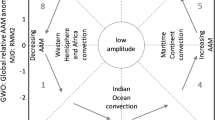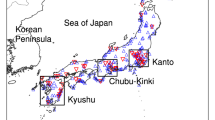Abstract
Previous studies have searched for relationships between tornado activity and atmospheric teleconnections to provide insight on the relationship between tornadoes, their environments, and larger scale patterns in the climate system. Knowledge of these relationships is practical because it can improve seasonal and sub-seasonal predictions of tornado probability and, therefore, help mitigate tornado-related losses. This study explores the relationships between the annual and seasonal tornado activity in the United States and the Global Wind Oscillation. Time series herein show that phases of the Global Wind Oscillation, and atmospheric angular momentum anomalies, vary over a period of roughly 20–25 years. Rank correlations indicate that tornado activity is weakly correlated with phases 2, 3, and 4 (positive) and 6, 7, and 8 (negative) of the Global Wind Oscillation in winter, spring, and fall. The correlation is not as clear in summer or at the annual scale. Non-parametric Mann–Whitney U tests indicate that winters and springs with more phase 2, 3, and 4 and fewer phase 6, 7, and 8 days tend to have more tornadoes. Lastly, logistic regression models indicate that winters and springs with more phase 2, 3, and 4 days have greater likelihoods of having more than normal tornado activity. Combined, these analyses suggest that seasons with more low atmospheric angular momentum days, or phase 2, 3, and 4 days, tend to have greater tornado activity than those with fewer days, and that this relationship is most evident in winter and spring.

(adapted from Weickmann and Berry (2009), Gensini and Marinaro (2016), and https://www.esrl.noaa.gov/psd/map/clim/test_ maproom.html)






Similar content being viewed by others
References
Allen JT, Tippett MK, Sobel AH (2015) Influence of the El Niño/Southern Oscillation on tornado and hail frequency in the United States. Nat Geosci 8:278–283
Ashley WS, Strader SM (2016) Recipe for disaster: how the dynamic ingredients of risk and exposure are changing the tornado disaster landscape. Bull Am Meteorol Soc 97:767–786
Barrett BS, Gensini VA (2013) Variability of central United States April–May tornado day likelihood by phase of the Madden–Julian Oscillation. Geophys Res Lett 40:2790–2795
Brooks HE, Doswell CA III (2001) Some aspects of the international climatology of tornadoes by damage classification. Atmos Res 56:191–201
Brooks HE, Carbin GW, Marsh PT (2014) Increased variability of tornado occurrence in the United States. Science 346:349–352
Cook AR, Schaefer J (2008) The relation of El Niño–Southern Oscillation (ENSO) to winter tornado outbreaks. Mon Weather Rev 136:3121–3137
Dickey JO, Gegout P, Marcus SL (1999) Earth–atmosphere angular momentum exchange and ENSO: the rotational signature of the 1997–98 event. Geophys Res Lett 26:2477–2480
Dickey JO, Marcus SL, Chin TM (2007) Thermal wind forcing and atmospheric angular momentum: origin of the Earth’s delayed response to ENSO. Geophys Res Lett 34:L17803
Doswell CA III (1987) The distinction between large-scale and mesoscale contribution to severe convection: a case study example. Weather Forecast 2:3–16
Doswell CA III, Brooks HE, Kay MP (2005) Climatological estimates of daily local nontornadic severe thunderstorm probability for the United States. Weather Forecast 20:577–595
Elsner JB, Elsner SC, Jagger TH (2015) The increasing efficiency of tornado days in the United States. Clim Dyn 45:651–659
Elsner JB, Jagger TH, Fricker T (2016) Statistical models for tornado climatology: long- and short-term views. PLoS One 11:e0166895
Farney TJ, Dixon PG (2014) Variability of tornado climatology across the continental United States. Int J Clim 35:2993–3006
Fricker T, Elsner JB, Jagger TH (2017) Population and energy elasticity of tornado casualties. Geophys Res Lett 44:3941–3949
Gensini VA, Marinaro A (2016) Tornado frequency in the United States related to global relative angular momentum. Mon Weather Rev 144:801–810
Guo L, Wang K, Bluestein HB (2016) Variability of tornado occurrence over the continental United States since 1950. J Geophys Res Atmos 121:6943–6953
Johns RH, Doswell CA III (1992) Severe local storms forecasting. Weather Forecast 7:588–612
Kunkel K, Karl T, Brooks H, Kossin J, Lawrimore J, Arndt D, Bosart L, Changnon D, Cutter S, Doesken N, Emanuel K, Groisman PY, Katz RW, Knutson T, O’Brien J, Paciorek CJ, Peterson TC, Redmond K, Robinson D, Trapp JT, Vose R, Weaver S, Wehner M, Wolter K, Wuelbbles D (2013) Monitoring and understanding trends in extreme storms. Bull Am Meteorol Soc 97:499–514
Lee S-K, Atlas R, Enfield D, Wang C, Liu H (2013) Is there an optimal ENSO pattern that enhances large-scale atmospheric processes conducive to tornado outbreaks in the United States? J Clim 26:1626–1642
Lee S-K, Wittenberg AT, Enfield DB, Weaver SJ, Wang C, Atlas R (2016) US regional tornado outbreaks and their links to spring ENSO phases and North Atlantic SST variability. Env Res Lett. doi:10.1088/1748-9326/11/4/044008
Marzban C, Schaefer J (2001) The correlation between US tornados and Pacific sea surface temperatures. Mon Weather Rev 129:884–895
McCarthy D, Schaefer J (2004) Tornado trends over the past thirty years. Preprints. In: 14th conference on applied climatology, Seattle
Moore TW (2017) On the temporal and spatial characteristics of tornado days in the United States. Atmos Res 184:56–65
NWS (2016) Natural hazard statistics. http://www.nws.noaa.gov/om/hazstats.shtml. Accessed 14 May 2017
SPC (2016) Severe weather database files (1950–2015). http://www.spc.noaa.gov/wcm/. Accessed 14 May 2017
Thompson DB, Roundy PE (2013) The relationship between the Madden–Julian Oscillation and US violent tornado outbreaks in the spring. Mon Weather Rev 141:2087–2095
Thompson RL, Smith BT, Grams JS, Dean AR, Broyles C (2012) Convective modes for significant severe thunderstorms in the contiguous United States. Part II: Supercell and QLCS tornado environments. Weather Forecast 27:1136–1154
Tippett MK (2014) Changing volatility of US annual tornado reports. Geophys Res Lett 41:6956–6961
Tippett MK, Cohen JE (2016) Tornado outbreak variability follows Taylor’s power law of fluctuation scaling and increases dramatically with severity. Nat Commun 7:10668. doi:10.1038/ncomms10668
Tippett MK, Allen JT, Gensini VA, Brooks HE (2015) Climate and hazardous convective weather. Curr Clim Change Rep 1:60–73
Verbout SM, Brooks HE, Leslie LM, Schultz DM (2006) Evolution of the US tornado database: 1954–2003. Weather Forecast 21:86–93
Weickmann KM, Berry E (2007) A synoptic-dynamic model of subseasonal atmospheric variability. Mon Weather Rev 135:449–474
Weickmann KM, Berry E (2009) The tropical Madden–Julian oscillation and the global wind oscillation. Mon Weather Rev 137:1601–1614
Author information
Authors and Affiliations
Corresponding author
Rights and permissions
About this article
Cite this article
Moore, T.W. Annual and seasonal tornado activity in the United States and the global wind oscillation. Clim Dyn 50, 4323–4334 (2018). https://doi.org/10.1007/s00382-017-3877-5
Received:
Accepted:
Published:
Issue Date:
DOI: https://doi.org/10.1007/s00382-017-3877-5




